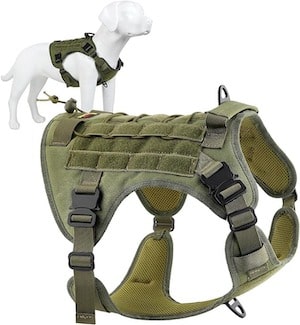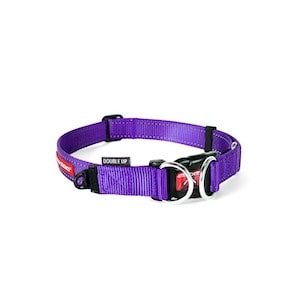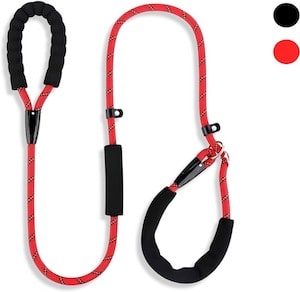As a dog owner, you may have wondered – dog zoomies after walk what should I do? For those who are new to this behaviour, a dog zoomies when they are excited. This excitement may be a result of any activity such as playing or simply walking.
Many dog owners have observed this sudden burst in their dog’s energy levels and seen them run to and fro without any reason. The majority of the time, this happens after walking. So, it’s obvious for you to wonder – why does my dog go crazy after a walk? Let’s find out.
You Might Also Like:
Dog Zoomies After Walk
Dog zoomies after a walk because of the exercise they received and the excitement. This instance is also referred to as overstimulation. So, after a successful walk, you will observe different behaviour from your furry friend. Below are some of the behavioural traits when your dog zoomies after a walk:
- Sprinting and rushing back and forth in different rooms of the house
- Running continuously with their mouth wide open showing excitement
- You will see them occasionally bow playfully and the joy of running around the house is visible on their face is visible
As a vet, we refer to zoomies as Frenetic Random Activity Periods (FRAPs). This basically means a sudden burst of energy on different occasions featuring repetitive, frantic, behaviour such as running in circles and spinning around.
These hyperactive behaviour traits are often reflected when a dog has had a stimulating activity, in this case, walking. Dogs become hyperactive after the release of the cortisol hormone and the excessive release often results in zoomies.
Here are some of the reasons why dogs get zoomies after a walk:
- They are happy because of the exercise they got after walking
- The dog feels excited to spend time with the dog owner while walking so afterwards they will show hyperactive behaviour on reaching home
- The joy of being outside for that specific period of time also results in zoomies after a walk
Further, when you are out for a walk, your dog may also catch a Zoomie. This happens when they see a group of dogs running around in circles. Your dog will also feel the excitement and there is an instant instinct for them to join the group.
You can allow your dog to join the other dogs and allow them to release their energy with other canines. Otherwise, they will try and rush off even with the harness on and this can hurt them and also make your control difficult.
We know the reasons for zoomies in dogs after a walk. Now it’s time we get into the specifics of the underlying cause and explore some additional reasons.
Zoomies in dogs – Cause
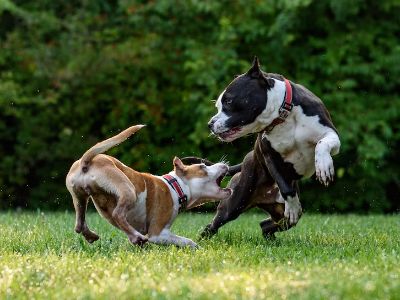
Walking does have a significant role in initiating hyperactive behaviour but, there are plenty of other causes that trigger the Frenetic Random Activity Periods. Following are some of the causes that I found common over the years of assessment of dog’s behaviour as a vet:
#1 Exercise
Because your dog has had no activity all day, zoomies are their way of using their energy. When you take them out for a walk or exercise, they will release all their energy into that activity. So, there is a high chance of a Zoomie episode.
You need to allow your dog to blow off some steam. Use your backyard and keep them off leash and let them use their energy running all around the backyard.
#2 Poop celebration
When your dog has held on to their poop for too long they don’t feel so good. So, when they are able to release their poo the joy and relief from pooping often results in zoomies. The reason is obvious, they feel like tons of weight is lost and the bladder is no longer under pressure. They will sprint around the house and celebrate the good poop release.
#3 Release stress and anxiety
Dogs often have Zoomie episodes when they are looking to cope with stress and anxiety. But, how will you identify whether they are having a stressed-out episode? Well, in my experience, I usually suggest that dog owners look out for their dog’s body movement.
The body movements will give away the following signs – lethargy, disinterest in activities or playing, and aggression. In such situations, you will see them zoom around the house exhibiting these signs. As a professional vet advisor, I will suggest dog owners allow their dogs some leeway and let them get stress free by zooming out.
#4 Bathing
This may come as a surprise but, many dogs get zoomies because they love bathing. The joy and excitement they feel by knowing they are getting a bath often trigger zoomies. The feeling of having a heavy coat often makes them go into zoomie mode.
However, post-bathing, when they are getting their coat dry their zooming begins to cool down. There is a sense of release and calmness, they feel refreshed and get into a good mood. In addition, the dogs who don’t prefer bathing may also get zoomies.
This happens because they have been made to maintain a specific posture for 15-20 minutes in the bathroom and the joy of bathing being complete is what triggers their zoomie episode. The feeling of not having to sit in a single position for 20 minutes is what makes them happy.
#5 Playing
If you have set up a routine of playing, you will see your dog get zoomies right before the time of play. So, when you are not preparing or showing any indications of playing, they will engage with you. They are already excited and you will see them bark and grab your hands to let you know it’s playtime.
In such instances, it’s important you acknowledge their attempt and play with them. Otherwise, they will redirect this energy into running. You may think – what’s the harm? But, trust me, you don’t want your furry friend running around like crazy. Because they may end up hurting themselves, destroying things, or worst escaping.
#6 Age
In general, puppies and young dogs get more zoomies than the old age ones. However, the notion that senior dogs don’t get zoomies is not an accurate assumption. As a Vet, I can tell you one thing, after analysing dogs’ behaviour for years, I have seen many old-age dogs have zooming episodes.
So, you shouldn’t be surprised if your old-age dog gets zoomies. Yes, dogs at a young age are more prone to this behaviour but, this doesn’t imply the senior ones are an exception.
#7 Tired
Dogs who are tired after intense exercise or spending active days will have zoomies. This seems contrary but, it’s true. This mainly happens when they are awake after their bedtime. The routine you set for them is always going to have an impact. Their body is responding to the clock cycle they usually follow.
Hence, it’s crucial you avoid breaking their sleep cycle. You need to try and calm their behaviour and put them to sleep rather than making them play or encouraging their zoomies.
#8 Ignoring you
Your dog might also have zoomies when they try ignoring you. They do this in an attempt to indicate to you they want to be left alone or simply ignore you. It’s also possible they are trying to defend themselves.
Regardless, such zoomies are not good because you can never anticipate their outburst. So, instead of making them exercise or play, try analysing their behaviour and see whether they are in stress or not. Still, if you are not progressing with the assessment, a vet visit is your best bet in such zooming episodes.
#9 Food
After having a delicious food treat, it’s possible your dog will exhibit excitement. The food will also elevate their energy levels so, it’s obvious they will look to release this energy. The energy levels after having the meal are so high that sometimes a simple walk won’t help tackle your dog’s crazy energy outburst.
Hence, you may have to use running exercises to handle the dog’s energetic outburst. If you are thinking of changing their diet content or the ingredients don’t it will make them feel sad and the stress from such instances can also make them have a zoomie.
#10 Teething
When young pups are teething, their urge to chew takes over. This can also make them hyperactive and you will see them running around to find stuff for chewing or simply cope with the pain they suffer. So, when you see them running around in the house while they are teething, you can offer them chew toys or small food treats.
These were some of the common causes of zoomies in dogs. Now, let’s see how we can calm a dog who is running around crazy.
How To Calm a Dog Having Zoomie?
Well, there is no precise method that you can use. Their zoomies are intense and you can get caught up in the whirlwind. It’s important you allow them to offload this energy, you cannot stop them but, you can try using some tricks to help them calm down.
It’s a good idea to always carry a dog walking bag on your walks. This allows you to bring water, treats, waste bags, and other supplies to manage your dog’s energy during and after the walk
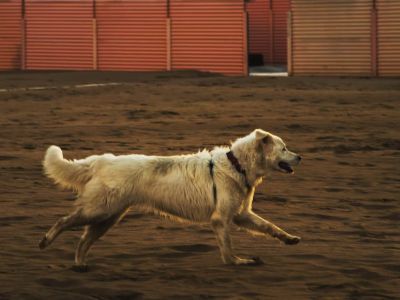
- Don’t engage
The basic trick is to try and interrupt their play without engaging. You can use some toys and put them in their path. See if they take the bait. Because even if they keep running, the interruption will slow them down and their behaviour will shift back to normal after some time.
- Use commands
If you have set up some commands or cues suggesting the playtime is over, use them. If you are lucky, then this trick may work. Often dogs respond to such commands and halt their crazy running. You can follow the same training method you used to make them obey other cues such as “sit”, “go” and so on.
- Training
Training your dog to control its urges is your best shot at preventing FRAPs (Frenetic Random Activity Periods). The training for helping them cope with the zoomies will mainly involve using tricks that will help redirect their focus from a particular activity.
For instance, delicious food treats on a lick mat can distract them while they are having a random Zoomie episode. Licking and chewing helps them relax, and you will see their behaviour calm down after they have an intense Zoomie episode.
- Spread out the food treats
You can randomly spread out food treats or chew toys in your backyard and in the house. This is basically a bait to help channel the dog’s instant energy burst into a different activity. This trick comes in handy if your dog is frequently having zoomies after walking. The spread treats will distract them and when they see them, they will stop and have a sniff.
Many dog owners have used this strategy. in fact, many of them also make this a training session and add other puzzle treats for their dogs. The only possible drawback is that you may have to spend more on food treats and chew toys.
- Crate train
You can always use a crate for puppies and train them to spend more time there, especially when they feel stressed, or over-excited. Make them feel this is a safe space and their own, this helps in ensuring they don’t act on their impulses.
- A long walk or running
Zoomies are dogs’ way of utilising the energy they have. So, you can try to walk more with your dog and see if it helps. You can also try running exercises and make them burn off the energy. However, in my experience, a long walk solves the FRAPs issue in most dogs. You may only need to make them run if they are highly energetic dog breeds.
- Supplements
In rare cases, if your dog is having zoomies because of stress or anxiety, you can use calming supplements for managing their behaviour and avoiding any incident. So, before you rush into using any supplements or medicine, consult a vet and make sure that your dog’s zoomie is actually being caused because of stress. Because in my experience, most of the time the zoomies reflect excitement rather than stressful feeling.
If your dog is having a zoomie episode but is also sick with something like kennel cough, you’ll need to modify your approach. Kennel cough can make dogs feel under the weather, so vigorous exercise like long walks may not be a good idea. Check with your vet on what activities are okay if you’re wondering – can I walk my dog with kennel cough?
Safety tips for keeping the dog and family safe
You have different methods to calm your dog down while they have zoomies. But, it’s also crucial to prepare some precautionary measures to keep both dog and family members safe. Because you never know when your dog may start running around.
Here are some ways you can ensure safety for your furry friend as well as family members:
1) Safety of Dogs
- The slightest contact with any toy or sharp edge material in your backyard can injure your dog. So, avoid keeping hard toys or any such material. They can easily hurt themselves because while they are running in the backyard they may not notice these objects.
- Make sure your backyard is well-maintained. Uneven surfaces or holes in the ground can also cause severe injuries. For instance, a rupture in the cruciate ligament, the leg getting stuck in one of the holes can disrupt their swift movement and the force exerted can tear the ligament.
- Don’t leave your dog off leash without a harness, especially in public areas. They may randomly start running and create chaos for the people around them.
- When you have an approximate idea regarding when your dog gets a zoomie, avoid areas such as stairs, high-end places, or indoor hazards. Also, try making your home dog-proof. This means, covering all the sharp edges and corners of the house to avoid injuries.
Don’t walk too many dogs at once. Walking more than 2 or 3 dogs can be difficult to control, especially if one has zoomies. Check your local leash laws to see how many dogs can you walk?
2) Safety for family members
- If the zoomie behaviour is quite intense, build a crate and train them to get into their crate when they feel overwhelmed. Use different cues or simply point them towards their crate.
- Whenever your dog shows signs of zoomie behaviour in the presence of family members, take them out for a walk or simply throw a ball in your garden. This will divert their attention and you can ensure the safety of your family. Because if they start running in the house, they may get hurt when the dog keeps running around.
FAQs
What age do puppy zoomies stop?
In comparison to adult and senior dogs, zoomies normally strike puppies and young dogs more. You may notice the signs often at an early age and by the time they hit the age of 6 or 8, you will see a sharp decline. By the age of 10, these dogs completely outgrow these zoomies and there are rarely any episodes.
What Breeds are prone to zoomies?
From Basset Hounds to Great Danes, every dog gets zoomies. You will see young dogs and puppies zip around more because of their highly energetic nature. They all are looking to burn off their energy. Zoomies in such highly energetic dogs are quite normal and at their young age dog owners do struggle to cope with their intense zoomies.
How long does a dog zoomies after walking?
There is no exact time duration or a way to suggest how long a zoomie will last but, in general, dog owners have observed the behaviour last for about 5-10 minutes. Along with the energy factor, there are many factors such as stress, excitement, tiredness, etc. involved in triggering a zooming episode so, this tentative timeframe may elevate or lessen as per the underlying cause which triggers such instances.
What triggers zoomies in dogs?
Generally, dogs get zoomies because there is excessive physical energy contained in them. They are looking to burst out this energy and use it for any particular activity. So, when they find a window of opportunity they will pounce on it and release this energy. because their actions are often intense dog owners get worried about such behaviour but, if the dog is happy, there is nothing to be worried about.
How to stop aggressive zoomies in dogs?
To stop aggressive zoomies in dogs you will have to plan a robust activity schedule and long walks throughout the day. This will provide your dog with enough opportunities to release the energy and you will see their aggressive zooming episodes will also stop. For better results, try scheduling their walks in the morning and early evening.
Authors Remark
There is no reason for you to panic when your dog zoomies after walking. This behaviour is normal for pretty much every dog breed and is manageable. Yes, different breeds will reflect different behaviour but, the ultimate aim is to release their curated energy.
You can use different strategies to manage your dog’s zooming episodes. For the ones after walking, simply try extending the distance i.e. if your dog walks two kilometres try walking three or four. This may help release their energy completely and you won’t have to worry about them having a zoomie after walking.
Lastly, if your dog is having frequent zoomies, you will have to consult a behaviourist for determining any underlying condition. The behaviourist will suggest if the episodes are happening as usual or because of stress, anxiety, or other trauma. You can find a behaviourist near you with the help of the Animal Behaviour and Training Council (ABTC) and get insights into your dog’s mental status.
